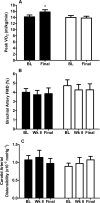Effect of endurance exercise training on endothelial function and arterial stiffness in older patients with heart failure and preserved ejection fraction: a randomized, controlled, single-blind trial
- PMID: 23665370
- PMCID: PMC3740089
- DOI: 10.1016/j.jacc.2013.04.033
Effect of endurance exercise training on endothelial function and arterial stiffness in older patients with heart failure and preserved ejection fraction: a randomized, controlled, single-blind trial
Abstract
Objectives: The study sought to evaluate the effects of endurance exercise training (ET) on endothelial-dependent flow-mediated arterial dilation (FMD) and carotid artery stiffness, and their potential contributions to the training-related increase in peak exercise oxygen consumption (Vo2) in older patients with heart failure with preserved ejection fraction (HFPEF).
Background: Elderly HFPEF patients have severely reduced peak Vo2, which improves with ET, however, the mechanisms of this improvement are unclear. FMD and arterial distensibility are critical components of the exercise response and are reduced with aging. However, it is unknown whether these improve with ET in elderly HFPEF or contribute to the training-related improvement in peak Vo2.
Methods: A total of 63 HFPEF patients (age 70 ± 7 years) were randomized to 16 weeks of ET (walking, arm and leg ergometry, n = 32) or attention control (CT) (n = 31). Peak Vo2, brachial artery FMD in response to cuff ischemia, carotid artery distensibility by high-resolution ultrasound, left ventricular function, and quality of life were measured at baseline and follow-up.
Results: ET increased peak Vo2 (ET: 15.8 ± 3.3 ml/kg/min vs. CT: 13.8 ± 3.1 ml/kg/min, p = 0.0001) and quality of life. However, brachial artery FMD (ET: 3.8 ± 3.0% vs. CT: 4.3 ± 3.5%, p = 0.88), and carotid arterial distensibility (ET: 0.97 ± 0.56 vs. CT: 1.07 ± 0.34 × 10(-3) mm·mm Hg(-2); p = 0.65) were unchanged. Resting left ventricular systolic and diastolic function were unchanged by ET.
Conclusions: In elderly HFPEF patients, 16 weeks of ET improved peak Vo2 without altering endothelial function or arterial stiffness. This suggests that other mechanisms, such as enhanced skeletal muscle perfusion and/or oxygen utilization, may be responsible for the ET-mediated increase in peak Vo2 in older HFPEF patients. (Prospective Aerobic Reconditioning Intervention Study [PARIS]; NCT01113840).
Keywords: A-Vo(2)Diff; B-type natriuretic peptide; BNP; CT; ET; FMD; HF; HFPEF; HFREF; LV; QOL; RER; Vo(2); Vo(2)peak; aging; arteriovenous oxygen difference; attention control; exercise; exercise training; flow-mediated arterial dilation; heart failure; heart failure with preserved ejection fraction; heart failure with reduced ejection fraction; left ventricular; oxygen consumption; peak exercise oxygen uptake; preserved ejection fraction; quality of life; respiratory exchange ratio.
Copyright © 2013 American College of Cardiology Foundation. Published by Elsevier Inc. All rights reserved.
Figures
Comment in
-
Exercise training in patients with heart failure and preserved ejection fraction: findings awaiting discovery.J Am Coll Cardiol. 2013 Aug 13;62(7):593-4. doi: 10.1016/j.jacc.2013.01.098. Epub 2013 May 9. J Am Coll Cardiol. 2013. PMID: 23665368 Free PMC article. No abstract available.
References
-
- Kitzman DW, Gardin JM, Gottdiener JS, et al. Importance of heart failure with preserved systolic function in patients >/= 65 Years of Age. CHS Research Group. Cardiovascular Health Study. Am J Cardiol. 2001;87:413–9. - PubMed
-
- Owan TE, Hodge DO, Herges RM, et al. Trends in prevalence and outcome of heart failure with preserved ejection fraction. N Engl J Med. 2006;355:251–9. - PubMed
-
- Kitzman DW, Higginbotham MB, Cobb FR, et al. Exercise intolerance in patients with heart failure and preserved left ventricular systolic function: failure of the Frank-Starling mechanism. J Am Coll Cardiol. 1991;17:1065–72. - PubMed
-
- Kitzman DW, Little WC, Brubaker PH, et al. Pathophysiological characterization of isolated diastolic heart failure in comparison to systolic heart failure. JAMA. 2002;288:2144–50. - PubMed
Publication types
MeSH terms
Associated data
Grants and funding
LinkOut - more resources
Full Text Sources
Other Literature Sources
Medical
Research Materials
Miscellaneous


